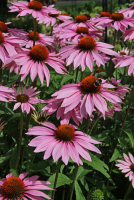
Add a new dimension to your garden displays by not only planting colourful flowers you can enjoy throughout the year, but ones that will bring in the butterflies too. A wide range of bedding plants, perennials, flowering shrubs and bulbs produce the simple, open blooms that butterflies love.
These act like fuelling stations around our gardens for butterflies, moths, bees and other beneficial insects, providing them with the valuable nectar they need to feed on for energy. That’s why the best flowers are often described as nectar plants, and there are hundreds of wonderful plants to choose from to suit virtually any site or soil you have in your garden.
One of the most popular is the Butterfly Bush, or Buddleja, a hardy and reliable shrub whose flowers act like magnets for butterflies, hence their common name. Many strong-growing varieties are available, including one with variegated foliage called ‘Harlequin’, but all can be kept within bounds by annually pruning in early spring.
Several dwarf and compact varieties of Butterfly Bush are now available that are perfect for pots or tiny spaces, with flowers in colours from pink and white to blue, lavender, magenta and deep purple.
Plan your planting carefully to choose a range of plants that flower right through the year, as these will both attract and support the widest range of butterflies in your garden. Some of the best flowering perennials provide long-lasting displays, with a succession of flowers opening over several months. These include varieties of Rudbeckia and Cone Flower (Echinacea), both valued for their outstanding garden performance.
Lavenders provide welcome nectar for butterflies through the summer months, while planting a range of Ice Plants (Sedum) ensures more flowers develop into autumn to feed Small Tortoiseshell and other late-flying butterflies as they prepare for hibernation.
With over 50 species of butterfly resident in the UK, and dozens more flying across from Europe, our gardens can play a vital role in ensuring their survival, and we can enjoy their antics too.
TOP FOUR PLANTS TO BRING IN THE BUTTERFLIES
Butterfly Bush (Buddleja davidii varieties and others)
Including AGM varieties like ‘Nanho Blue’, ‘Royal Red’, ‘White Profusion’ and ‘Harlequin’.
Ice Plant and Sedum (Including Sedum spectabile and Sedum telephinium)
AGM varieties to consider: ‘Brilliant’, Atropurpureum Group, ‘Purple Emperor’, ‘Thundercloud’
Cone Flower (Echinacea) – lots of varieties to choose from
Rudbeckia varieties, including ‘Goldsturm’ and ‘Pot of Gold’
TOP TIPS FOR PLANNING AND PLANTING
- Choose a range of suitable plants with different flowering periods to ensure there’s something in bloom throughout spring, summer and autumn for butterflies to feed from.
- Several butterflies hibernate through winter. Adults emerging from hibernation need flowers to feed on in spring. Others require autumn blooms to stock-up on nectar to help them survive during hibernation.
- While flowers are important to feed adult butterflies do remember that different plants are needed for butterflies to lay their eggs on and to feed their caterpillars.
- Letting patches of nettles established in a wild or natural areas provide valuable breeding and feeding sites for four of our native butterflies. The caterpillars of Small Tortoiseshell, Red Admiral, Comma and Peacock all feed on nettle leaves.
- Avoid using pesticides around your garden that could harm butterflies, bees, ladybirds and other beneficial creatures.
- For more information check out the web site of Butterfly Conservation at www.butterfly-conservation.org
OTHER FAVORITE PLANTS OF THE MOMENT
There are dozens of suitable flowering plants to choose from that can provide nectar in different seasons for butterflies to enjoy. Lists of the best can be found online, such as on the RHS web site (www.rhs.org.uk), and here are just a few to consider:
- Aubretia
- Bugle (Ajuga)
- Ceanothus
- Coreopsis
- Cosmos
- Cranesbill (Hardy Geraniums)
- Dahlia
- Globe Thistle (Echinops)
- Heather
- Hebe
- Helenium
- Lavender
- Michaelmas Daisy (Aster varieties)
- Marjoram (Oregano)
- Phlox
- Scabious
- Statice
- Verbena bonariensis
